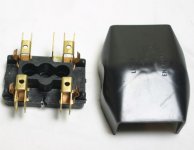The Cone of Silence
Member
Offline
G'day all,
Despite the car working perfectly well, the tachometer and fuel gauge have stopped working. On the tacho the ignition light still operates as it should but the needle refuses to move.
Similarly, the fuel gauge has also ceased to make any effort at all to indicate the level of fuel, which is dreadfully rude I'm sure you'll agree.
All other instruments are fine and perfectly operational.
I'm a little confused. Actually I'm flummoxed. The cables at the back look alright.....under the hood what should I be looking for? What does the tacho connect to?
Tried to get into the fuse box to have a look but couldn't get the lid off and didn't want to snap anything. What's the technique?
I appreciate any assistance and advice that you might be able to give me.
Thanks
Bobby
Despite the car working perfectly well, the tachometer and fuel gauge have stopped working. On the tacho the ignition light still operates as it should but the needle refuses to move.
Similarly, the fuel gauge has also ceased to make any effort at all to indicate the level of fuel, which is dreadfully rude I'm sure you'll agree.
All other instruments are fine and perfectly operational.
I'm a little confused. Actually I'm flummoxed. The cables at the back look alright.....under the hood what should I be looking for? What does the tacho connect to?
Tried to get into the fuse box to have a look but couldn't get the lid off and didn't want to snap anything. What's the technique?
I appreciate any assistance and advice that you might be able to give me.
Thanks
Bobby

 Hi Guest!
Hi Guest!

 smilie in place of the real @
smilie in place of the real @
 Pretty Please - add it to our Events forum(s) and add to the calendar! >>
Pretty Please - add it to our Events forum(s) and add to the calendar! >> 


